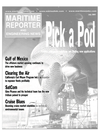
Page 29: of Maritime Reporter Magazine (July 2001)
Read this page in Pdf, Flash or Html5 edition of July 2001 Maritime Reporter Magazine
EBQBBBiamaSEia eport
Owners... Start Counting The Cash
The much anticipated turnaround in the Gulf of Mexico Oil Patch is happening, and the companies that supply boats and services in the area are feeling the impact.
Consolidation has touched every facet of the marine business — every facet of business — for nearly a decade. Following the economic slow- down and resultant "weeding out of the weaklings" in the early 1990s, a new business plan stressing size and economic resource emerged. The plan, obviously, has not worked universally, as some companies overextended just as the market came crashing down in 1997. Today, for better or worse, a handful of enormous companies reign over the business of owning and operating vessels and rigs in the
Gulf of Mexico region.
Seacor Smit is perhaps the best example of controlled growth and adhering to a solid business plan — in times good and bad. Led by
Charles Fabrikant, the company has amassed one of the world's largest fleets of diversified marine support vessels primarily dedicated to supporting offshore oil and gas exploration and development in the
U.S. Gulf of Mexico, offshore West
Africa, the North Sea, Mexico, the
Far East and Latin America. The company announced net earnings for the first quarter ended March 31, 2001 of $12,134,000 on revenues of $93,200,000.
Operating revenues were up $4.9 million, or 5.5 percent, from 4Q 2000 due, primarily, to increases in the size and rates per day worked of the company's offshore fleet. In the first quarter, Seacor continued its expansion tradi- tion and acquired 17 mini-supply, 11 utility, two towing supply and one supply vessel. Also in the first quarter, it sold three utility and three crew ves- sels, and removed three standby safety vessels from
I am cautiously opti- mistic that 2002 will be a good year, although any predic- tion that looks out more than one year has to be a guess ...
My nightmare is the
U.S. and global econo- my. Why, I ask myself, be optimistic when the
United States appears to be entering a reces- sion? ... The answer is
Natural Gas.
Charles Fabrikant,
Chairman of the Board,
Seacor Smit, in his annual letter to shareholders service to be held for sale.
Seacor. however, saw drydock expenses rise $1.6 million due to an increase in the number of large supply, towing supply and anchor handling towing supply vessels put through survey. Twenty-six ves- sels were drydocked in 1Q 2001, compared to 19 in 4Q 2000. 1Q 2001 results were positively impact- ed by $947,000 of income from Chiles Offshore
Inc., a drilling rig affiliate, whose profits improved parallel with strong demand for offshore contract drilling services.
Ft. Lauderdale-based Seabulk
International (formerly Hvide
Marine Intl.) continued on the road to recovery by announcing a net loss of $7.2 million versus a net loss of $12.9 million during the year-earlier period. While a loss may hardly seem like a gain, Seab- ulk said that revenues were up four percent (versus the year-earlier period) to $81.4 million, and that operating income hit $8.4 million versus $2 million in the 2000 first quarter. "We had good results in what is traditionally our weakest quarter," said Gerhard E. Kurz, president and CEO. "While we have not yet achieved bottom-line profitability ... we did post solid quarter-over- quarter gains." He noted that
Seabulk Offshore is benefiting from rising rates in the worldwide offshore energy support market, while Seabulk Tankers is in a strong position in the domestic product tanker market. Seabulk Offshore saw its revenues leap 26 percent to $43.2 million, or 53 percent of company revenues. Supply boat day rates in the Gulf of Mexico averaged $6,946 for the r^un ! ntu^fj • *§f f> "Now with leak detection" mm
Smart Radar Level
Sensor with Generic
RS485 Output
The first flat array antenna for liquid tank gauging.
This software driven array allows for each sensor to remotely configure itself for the type of product as well as the structural characteristics within each tank. It is completely self-diagnostic and is factory calibrated using a laser interferometer to .1mm. It is designed for the harshest environments and can be provided in a high temperature version to 385°F. It is intrinsically safe with Class 1, Div. 1,
Group D & C approvals. As a smart sensor, all processing calculations and software are resident in the device itself, only a high level generic data output, i.e., RS485 (or others on request) is sent to the cargo control area.
Options: • Multiple alarm set-points •Temperature • PV Pressure • I.G. Pressure • Tank Management Software • Automated draft and trim
ELECTRONIC MARINE
SYSTEMS, INC. 800 Ferndale Place
Rahway, NJ 07065
Call today for more information! 732.382.4344 732.388.5111 fax [email protected] e-mail http://www.emsmarcon.com
Circle 226 on Reader Service Card www.maritimereporterinfo.com
July, 2001 www.maritimetoday.com 29

 28
28

 30
30
